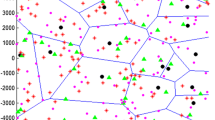Abstract
This paper presents a framework for coverage and capacity optimization (CCO) in HCNs from stochastic geometry theory. Unlike conventional approaches, we propose a concept of effective capacity as the optimization objective, which involves implicit index of coverage in the form of truncation function. The main idea is to model the coverage probability, average rate and joint objective considering noise where the location of base stations are spatially distributed as a Poisson Point Process. Under an adaptive power allocation assumption, we improve iterative approach with percentile level to find an effective increasing direction of transmit power. The simulation shows that the theoretical analysis and optimization objective are feasible and the adjustment of percentile level serves as a flexible solution for CCO.










Similar content being viewed by others
References
Khandekar, A., Bhushan, N., Tingfang, J., & Vanghi, V. (2010). LTE-advanced: Heterogeneous networks. In Proceedings of the IEEE EW 2010 spring, pp. 978–982.
Dhillon, H. S., Ganti, R. K., Baccelli, F., & Andrews, J. G. (2011). Coverage and ergodic rate in K-tier downlink heterogeneous cellular networks. In Proceedings of the IEEE Communication, Control, and Computing (Allerton) 2011, pp. 1627–1632.
Soszka, M., Berger, S., Fehske, A., et al. (2015). Coverage and capacity optimization in cellular radio networks with advanced antennas. In WSA 2015; 19th International ITG Workshop on Smart Antennas; Proceedings of VDE, pp. 1–6.
Athanasiadou, G. E., Zarbouti, D., & Tsoulos, G. V. (2014). Automatic location of base-stations for optimum coverage and capacity planning of LTE systems. In Antennas and Propagation (EuCAP), 2014 8th European Conference on IEEE, pp. 2077–2081.
Gutierrez-Estevez, D. M., Akyildiz, I. F., & Fadel, E. A. (2014). Spatial coverage cross-tier correlation analysis for heterogeneous cellular networks. IEEE Transactions on Vehicular Technology, 63(8), 1.
Suryaprakash, V., Moller, J., & Fettweis, G. (2015). On the modeling and analysis of heterogeneous radio access networks using a poisson cluster process. IEEE Transactions on Wireless Communications, 14(2), 1035–1047.
Chiu, S. N., Stoyan, D., & Kendall, W. S. (2013). Stochastic geometry and its applications. New Jersey: Wiley.
Haenggi, M., Andrews, J. G., Baccelli, F., Dousse, O., & Franceschetti, M. (2009). Stochastic geometry and random graphs for the analysis and design of wireless networks. IEEE Journal on Selected Areas in Communications, 27(7), 1029–1046.
Awada, A., Wegmann, B., Viering, I., & Klein, A. (2011). A joint optimization of antenna parameters in a cellular network using Taguchi’s method. In Proceedings of the IEEE VTC 2011 Spring, pp. 1–5.
Heath, R. W., Kountouris, M., & Bai, T. (2013). Modeling heterogeneous network interference using Poisson point processes. IEEE Transactions on Signal Processing, 61(16), 4114–4126.
Akoum, S., Kountouris, M., & Heath, R. W. (2011). On imperfect CSI for the downlink of a two-tier network. In Proceedings of the IEEE ISIT 2011, pp. 553–557.
Madhusudhanan, P., Restrepo, J. G., Liu, Y., & Brown, T. X. (2012). Heterogeneous cellular network performance analysis under open and closed access. In 2012 IEEE GC Workshops, pp. 563–568.
Dhillon, H. S., Ganti, R. K., & Andrews, J. G. (2011). A tractable framework for coverage and outage in heterogeneous cellular networks. In Proceedings of the IEEE ITA 2011 spring, pp. 1–6.
Dhillon, H. S., Ganti, R. K., & Andrews, J. G. (2013). Load-aware modeling and analysis of heterogeneous cellular networks. IEEE Transactions on Wireless Communications, 12(4), 1666–1677.
Novlan, T. D., Dhillon, H. S., & Andrews, J. G. (2013). Analytical modeling of uplink cellular networks. IEEE Transactions on Wireless Communications, 12(6), 2669–2679.
Chun, Y. J., Hasna, M. O., Ghrayeb, A., & Renzo, M. D. (2015). On modeling heterogeneous wireless networks using non-Poisson point processes. Cornell University Library. arXiv:1506.0629620.
Li, Y., Baccelli, F., Dhillon, H. S., et al. (2014). Statistical modeling and probabilistic analysis of cellular networks with determinantal point processes. Eprint Arxiv, 63(9), 1.
Luketic, I., Simunic, D., & Blajic, T. (2011). Optimization of coverage and capacity of self-organizing network in LTE. In Proceedings of the IEEE MIPRO 2011 spring, pp. 612–617.
Berger, S., Fehske, A., Zanier, P., et al. (2014). Online antenna tilt-based capacity and coverage optimization. Wireless Communications Letters, IEEE, 3(4), 437–440.
Razavi, R., Klein, S., & Claussen, H. (2010). Self-optimization of capacity and coverage in LTE networks using a fuzzy reinforcement learning approach. In Proceedings of the IEEE PIMRC 2010 fall, pp. 1865–1870.
Mitschele-Thiel, A., & Islam, M. N. U. (2012). Reinforcement learning strategies for self-organized coverage and capacity optimization. In Proceedings of the WCNC, pp. 2818–2823.
Islam, M. N. U., & Mitschele-Thiel, A. (2012). Cooperative fuzzy q-learning for self-organized coverage and capacity optimization. In Proceedings of the PIMRC, (pp. 1406–1411), NSW.
Awada, A., Wegmann, B., Viering, I., & Klein, A. (2011). A mathematical model for user traffic in coverage and capacity optimization of a cellular network. In Proceedings of the IEEE VTC 2011 Spring, pp. 1–5.
Fan, S., Tian, H., & Sengul, C. (2014). Self-optimization of coverage and capacity based on a fuzzy neural network with cooperative reinforcement learning. EURASIP Journal on Wireless Communications and Networking, 2014(1), 1–14.
Dhillon, H. S., Ganti, R. K., Baccelli, F., et al. (2012). Modeling and analysis of K-tier downlink heterogeneous cellular networks. IEEE Journal on Selected Areas in Communications, 30(3), 550–560.
Acknowledgments
This work by supported in part by the National Natural Science Foundation of China under Grant 61302081, the State Major Science and Technology Special Projects (Grant No. 2013ZX03003005).
Author information
Authors and Affiliations
Corresponding author
Rights and permissions
About this article
Cite this article
Wang, X., Song, M., Teng, Y. et al. Coverage and Capacity Optimization Analysis in Heterogeneous Cellular Networks Based on Truncated Function. Wireless Pers Commun 89, 385–403 (2016). https://doi.org/10.1007/s11277-016-3271-3
Published:
Issue Date:
DOI: https://doi.org/10.1007/s11277-016-3271-3




